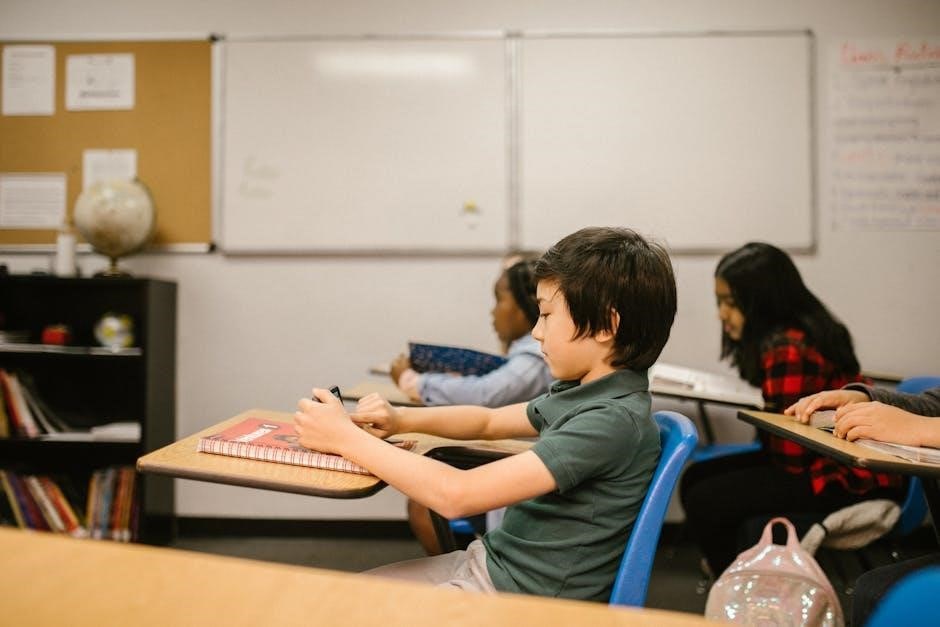This structured curriculum is designed to build foundational sewing skills, covering essential tools, techniques, and projects, while emphasizing creativity and practical applications for beginners.
1.1 Overview of the Curriculum Structure
The curriculum is structured into modules, starting with foundational skills like using sewing tools and machines, followed by fabric preparation and basic projects. It balances practical techniques with creative expression, ensuring a progressive learning experience. Hands-on activities and demonstrations guide students through essential tasks, such as threading machines, cutting patterns, and sewing straight lines. The curriculum emphasizes safety, confidence-building, and mastery of basic skills before introducing more complex techniques. This structured approach ensures learners gain a comprehensive understanding of sewing, preparing them for further creative projects and skill development.
1.2 Importance of Learning Sewing for Beginners
Learning sewing empowers beginners with a practical, creative skill that fosters confidence and self-expression. It enhances problem-solving abilities and patience while providing a sense of accomplishment. Sewing is not only a creative outlet but also a valuable life skill, enabling individuals to repair and customize clothing, reducing waste and saving money. It encourages personal growth, independence, and a deeper appreciation for handmade craftsmanship. For many, sewing becomes a therapeutic hobby, offering relaxation and fulfillment. Mastering sewing basics opens doors to endless creative possibilities, making it a rewarding skill for lifelong enjoyment and practical application.

Basic Sewing Skills and Equipment
Mastering basic sewing skills and equipment is essential for beginners. Key tools include scissors, pins, and sewing machines, while skills involve threading, straight stitching, and backstitching.
2.1 Essential Sewing Tools and Machines
Essential sewing tools include scissors, pins, tape measures, and seam rippers. Sewing machines are central, with mechanical and computerized options. Additional notions like threads, buttons, and zippers are vital. Understanding each tool’s purpose and proper use is key for beginners. Starting with basic equipment ensures a smooth learning curve. Familiarizing oneself with these tools early on builds confidence and skill. Proper care and maintenance of machines and tools extend their lifespan and performance. Investing in quality tools, even for beginners, enhances the sewing experience. This foundational knowledge is crucial for mastering sewing techniques and completing projects successfully.
2.2 Threading and Operating a Sewing Machine
Threading a sewing machine correctly is crucial for smooth operation. Start by guiding the thread through the spool pin and tension discs, then through the take-up lever and needle. Properly insert the bobbin into the machine’s bobbin case, ensuring it’s seated correctly. Practice sewing straight lines on scrap fabric to get comfortable with the machine’s speed and stitch length. Learn to backstitch at the beginning and end of seams for security; Regularly check thread tension and adjust as needed to prevent issues. Mastering these basics ensures reliable performance and sets the foundation for more complex techniques.
Fabric Preparation and Cutting
Understanding fabric types and textures is crucial for selection. Lay patterns accurately, ensuring grain alignment, and cut carefully with rotary tools or scissors for precise results.
3.1 Understanding Fabric Types and Textures
Beginners learn to identify fabric types like cotton, polyester, and blends, and understand their textures. This knowledge aids in selecting the right fabric for projects, ensuring durability and desired aesthetics.
3.2 Laying Out and Cutting Patterns
Accurate pattern layout and cutting are crucial for successful sewing projects. Students learn to align patterns with fabric grain, ensuring proper fit and symmetry. Tools like rotary cutters and mats simplify the process. Cutting techniques include using scissors or cutting wheels, with tips on handling curved edges and layered fabrics. Proper pinning and alignment prevent mistakes. Understanding how to work with pattern pieces and fabric folds is emphasized. This step ensures that garments and projects fit well and look professional, building confidence in beginners as they progress through the curriculum.
Sewing Projects for Beginners
Beginner-friendly projects like pillowcases, tote bags, and placemats are perfect for building confidence. These simple designs focus on straight lines and minimal complexity, ensuring a successful first creation.
4.1 Simple Projects to Build Confidence
Simple sewing projects, such as pillowcases, tote bags, and placemats, are ideal for beginners. These projects focus on straight lines and minimal complexity, allowing learners to build confidence quickly. By completing these tasks, students master basic techniques like sewing straight lines, securing seams, and finishing edges. These foundational skills are essential for progressing to more complex garments or home decor items. The satisfaction of creating something useful reinforces motivation and encourages further learning. Starting with these easy projects ensures a smooth transition into more advanced sewing challenges.
4.2 Step-by-Step Guide to Sewing a Basic Garment
A basic garment, such as an elastic waist skirt, is a great project for beginners. Start by preparing your fabric and cutting out the pattern. Sew straight seams, leaving a small hem allowance. Fold and press the waistband, then attach elastic for a comfortable fit. Finish seams to prevent fraying and ensure durability. Each step builds on the previous one, reinforcing essential sewing techniques. This project teaches learners to work with patterns, handle fabric, and complete a wearable item, providing a sense of accomplishment and readiness for more complex projects.

Advanced Beginner Techniques
Expanding skills, this section covers working with zippers, buttons, and sewing curves, while teaching how to finish seams professionally for polished results.
5.1 Working with Zippers and Buttons
Mastering zippers and buttons is a key step in advancing sewing skills; This section teaches how to accurately position and securely sew zippers, ensuring smooth operation. Students learn to sew buttonholes and attach buttons, either manually or using a sewing machine. Techniques include creating balanced button placement and using proper reinforcement for durability. Practical tips are provided for handling small parts and maintaining even spacing. These skills enhance both functional and decorative aspects of garments, boosting confidence and opening doors to more complex projects.
5.2 Sewing Curves and Finishing Seams
Sewing curves and finishing seams are essential skills for creating professional-looking garments. This section teaches techniques for smoothly navigating curved edges, ensuring fabric lies flat and even. Students learn to pin and sew curves accurately, using tools like seam rollers for crisp results. Finishing seams is also covered, with methods such as zigzag stitching, serging, or binding to prevent fraying. These techniques enhance durability and aesthetics, allowing beginners to produce polished, long-lasting pieces. Proper seam finishing is emphasized for a clean, professional finish, preparing students for more intricate projects.

Safety and Maintenance Tips
Proper handling of equipment, regular machine cleaning, and a clear workspace ensure safety and efficiency. Store tools safely to maintain their condition and prevent accidents effectively.
6.1 Proper Handling of Sewing Equipment
Proper handling of sewing equipment ensures safety and longevity. Always use scissors and rotary cutters with care, keeping fingers away from blades. Store sharp tools securely to prevent accidents. When using sewing machines, ensure the workspace is clear of clutter and cords. Keep children away from sewing equipment. Regularly inspect tools for damage and wear. Use the correct technique when threading needles or operating machines to avoid injury. Maintain a clean, organized workspace to reduce risks and improve efficiency. Proper handling habits foster a safe and enjoyable sewing experience for beginners.
6.2 Maintaining Your Sewing Machine
Regular maintenance ensures your sewing machine operates smoothly and extends its lifespan. Start by oiling moving parts as recommended in the manual. Clean the machine after each use with a soft brush or compressed air to remove fabric dust. Replace needles frequently to prevent breakage and damage. Use the correct needle size and type for your fabric to avoid machine strain. Store the machine in a dry, cool place, away from direct sunlight. For complex maintenance, consult a professional annually. Proper care enhances performance and prevents costly repairs, keeping your machine reliable for years of sewing projects.

Resources and Further Learning
Explore online tutorials, sewing communities, and free patterns to enhance your skills. Utilize YouTube for technique guidance and join forums for support and inspiration to build confidence.
7.1 Recommended Sewing Patterns for Beginners
Start with simple, versatile patterns like pillowcases, tote bags, or elastic waist skirts. These projects require straight lines and minimal complexity, making them ideal for building confidence. A basic garment, such as a t-shirt or a simple dress, is also a great next step. Look for patterns labeled “beginner-friendly” or “quick sews” from brands like Simplicity or McCalls. Additionally, explore free online patterns designed specifically for newcomers to sewing. These resources often include step-by-step instructions and video tutorials to guide you through the process, ensuring a smooth and enjoyable learning experience.
7.2 Online Tutorials and Sewing Communities
Online tutorials and sewing communities are invaluable resources for beginners. Platforms like YouTube and sewing blogs offer step-by-step guides for various techniques, while communities such as PatternReview and sewing forums provide support and feedback. These resources help learners troubleshoot common mistakes and gain confidence in their skills. Many websites also offer free sewing patterns and tips for choosing the right fabrics and tools. Engaging with online communities allows beginners to connect with experienced sewists, share projects, and stay motivated throughout their learning journey.
Completing the beginner sewing curriculum marks a significant milestone. Learners can now confidently create simple projects and transition to intermediate skills, exploring advanced techniques and patterns with ease.
8.1 Assessing Progress and Setting Goals
Assessing progress involves evaluating sewing skills through completed projects and feedback. Set realistic goals based on achievements, focusing on improving techniques and tackling more complex tasks. Reflect on strengths and areas needing improvement to create a tailored action plan. Celebrate milestones to stay motivated and track growth. Regular practice and dedication are key to advancing skills. Use feedback to refine your approach and explore new sewing challenges. Setting clear goals helps maintain focus and ensures steady progress in mastering sewing techniques.
